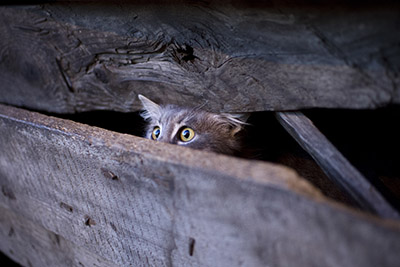Stray vs. Feral Cats: How to Spot the Difference

If you have ever uncovered an unknown kitty stalking the streets or gracing your garden, how would you react to it? On first impressions, it is an important step to figure out if this lone feline is a stray or a feral; though they all hail from domestic cats, there are key differences in their feelings towards humans and the approaches to aid them.
In this article, Petplan take a look at the important difference between stray and feral felines, including physical and behavioural characteristics, which can help you to potentially decipher if a cat is in need of rescue...
Stray Cats
A stray cat is defined as a feline that has experienced being ‘socialised’ as a domestic pet, but for unfortunate reasons has become lost or neglected from its home and human contact.
The amount of stray cats around the UK is continually on the rise and they can often be afraid, starving and possibly in poor health due to their unstable living conditions. Though a stray kitty can initially appear anxious and frightened towards people, these cats can successfully be rescued and rehabilitated as pets within a suitable home environment. With encouragement and patience, a stray cat can often re-acclimatise to her domestic surroundings – however, if a stray has been deprived of interaction for an extended time period, she can eventually become feral.
Feral Cats
A feral cat is identified as a kitty that has never encountered human interaction or has lost touch with human contact altogether, over an extensive period of time. Typically born from feral or stray cats, feral felines are accustomed to surviving in the great outdoors and are fearful of humans who attempt to approach them. Feral cats greatly lack hope in humans and when feeling threatened, they often can become aggressive and switch to attack mode. Experts advise against adopting feral cats as they are not likely to adapt to living indoors and having food provided for them – they are at peace living in the wild. However, kittens born to feral cats can be introduced to humans from birth and adopted into a safe home.
How to Spot the Difference: Key Signs
Understanding the difference between stray and feral felines can help you to decipher the best way to interact and additionally establish if interference is the right approach for the kitty’s well-being. Take a look at these key physical and behavioural signs, given to us by Petplan Vet Brian, to help tell the difference:
Physical Appearance
- A stray cat can often look unclean and have a dishevelled coat
- A feral cat will likely have clean fur and appear generally well-kept
- A stray cat that has been lost for several weeks can look underweight and unwell
- Male feral cats are often identified as having a muscular frame and scars from fighting
Behaviourisms
- A stray cat may approach you and walk with its tail high, showing friendliness
- A feral cat will always avoid human interaction when approached
- A stray cat may vocalise through meowing or purring when touched
- A feral cat won’t vocally communicate
- Stray cats tend to be visible to people during the daytime, seeking out food and shelter
- Feral cats are rarely active during the day, and are normally nocturnal
How to Help a Stray Cat
In the case of discovering a stray cat, it’s important to be aware of the different options available for the feline’s best interests. It is often a challenging experience uncovering an injured or lost kitty, however Petplan has a supportive guide, created with the help of the Blue Cross, which offers key advice on helping a stray cat. From providing advice on immediate action to helping a stray find a new home, our blog guide can help prepare you should the circumstance arise.


